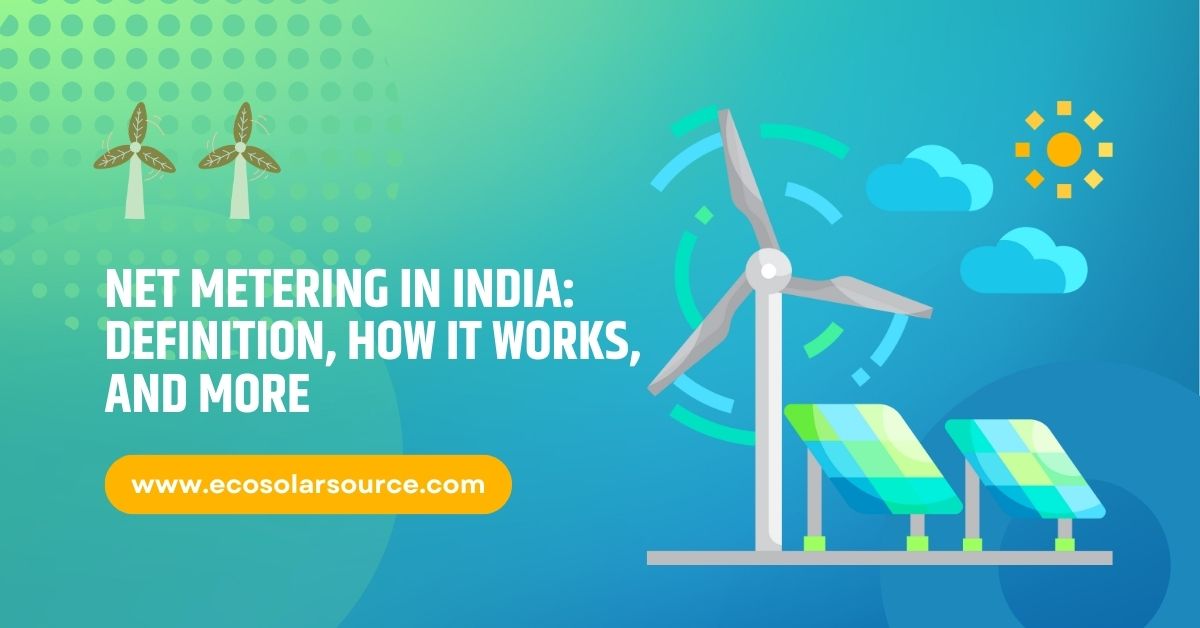Net Metering in India: Definition, How It Works, and More
Know the details about Net Metering in India: Definition, How It Works, and More, Explore everything you need to know about net metering in India, including its definition, benefits, and how it works. Our comprehensive guide covers the essential details on net metering policies, eligibility, and the advantages of generating your solar power. Learn how net metering helps reduce electricity bills, promotes renewable energy, and supports sustainable living.
Whether you’re a homeowner or business owner, this resource provides insights on how to maximize savings while contributing to a cleaner environment. Stay informed on the latest net metering regulations in India and start your journey toward energy independence today.
Table of Contents
Net Metering in India: Definition, How It Works, and More
Net metering has emerged as a key component in the expansion of renewable energy systems in India, empowering individuals and businesses to contribute to the nation’s sustainability goals. This comprehensive guide explores everything you need to know about net metering in India, including its definition, working principles, advantages, challenges, policies, and future potential.
Introduction to Net Metering
Net metering is a billing mechanism that allows individuals and businesses generating their electricity through renewable sources—such as solar or wind—to send excess electricity back to the grid. It enables users to offset their own consumption by crediting the surplus energy fed into the grid against their energy consumption during periods when they need additional electricity.

In India, the government has actively promoted net metering as a way to encourage renewable energy use, primarily through solar power, aligning with the country’s ambitious targets to reduce carbon emissions and increase energy independence. The Ministry of New and Renewable Energy (MNRE) and various state governments have set regulations to facilitate the adoption of net metering systems for both residential and commercial entities.
How Net Metering Works
The net metering system allows individuals or businesses with solar panels or other renewable energy systems to connect to the grid through a two-way meter that records both the incoming and outgoing energy. Here’s a step-by-step breakdown of how it works:
- Installation of Renewable Energy System: The user installs a renewable energy generation system, commonly solar panels, on their property.
- Grid Connection: The system is connected to the local grid through a bidirectional (or bi-directional) meter. This meter records the amount of energy consumed from the grid and the energy sent back to the grid.
- Energy Generation and Consumption: During the daytime, the solar panels generate electricity. Some of this electricity is used to meet the immediate energy needs of the consumer, and any excess is fed back to the grid.
- Meter Recording: The bi-directional meter calculates both the power taken from the grid (in case solar generation is insufficient) and the power sent back. The electricity provider then uses these readings to calculate the net usage.
- Billing: At the end of the billing period, the utility company subtracts the amount of electricity exported from the electricity imported, resulting in a “net” amount. If more electricity is exported than imported, the consumer receives credits or reduced charges for the excess power sent to the grid.
- Rolling Over Credits: In some states, net metering policies allow any surplus electricity credits to roll over to the next billing cycle. The regulations regarding how long credits can roll over may vary.
Types of Net Metering Policies in India
India’s net metering policies vary from state to state, with different rules and regulations governing how net metering works. Broadly, there are two types of metering mechanisms in the country:
- Gross Metering: In this arrangement, the entire electricity generated by the solar system is exported to the grid, and consumers are paid a predetermined tariff by the distribution company (DISCOM). Consumers purchase their entire electricity consumption from the grid separately, without using any of the electricity they generate themselves.
- Net Metering: Under net metering, consumers offset their consumption by feeding any excess energy back to the grid. They only pay for the net amount of energy consumed from the grid, minus what was exported. This is more common and popular, as it allows consumers to directly reduce their electricity bills.
Each state in India has different net metering limits and regulations. Some states cap the maximum size of the system allowed under net metering, and others provide incentives or rebates based on energy exported.
Net Metering Regulations and Guidelines in India
The net metering regulations in India are governed primarily at the state level, with each state having its regulatory commission that issues guidelines for the installation and operation of net metering systems. Key points of consideration include:

- System Size Limits: Many states impose a maximum capacity limit for rooftop solar systems that qualify for net metering. This can vary widely—some states may allow systems up to 1 MW, while others cap it at a few kilowatts.
- Connectivity Guidelines: States have set technical guidelines that govern how a solar energy system can be connected to the grid, including inverter specifications, grid synchronization, and safety standards.
- Metering and Billing: Bi-directional meters are used to track energy exported to and imported from the grid. Billing policies, such as whether surplus credits can be rolled over or cashed out at the end of a year, also vary by state.
- Eligibility Criteria: States specify who can apply for net metering, often prioritizing residential consumers, commercial entities, and government buildings.
- Approval Process: Each state’s regulatory commission provides a streamlined process for approval. For example, consumers may need to submit applications and technical documents and obtain necessary approvals from the local DISCOM.
Advantages of Net Metering
Net metering offers a variety of advantages that contribute to both individual and societal benefits:
- Reduction in Electricity Bills: Net metering allows consumers to reduce their electricity bills significantly by offsetting the cost of grid-supplied power with the energy they generate.
- Encouragement of Renewable Energy: It incentivizes the adoption of solar energy, reducing dependence on fossil fuels and contributing to environmental sustainability.
- Grid Stability and Reduced Demand: With more distributed generation, the load on the central grid is reduced, enhancing stability and reliability.
- Revenue Generation: Some consumers, especially commercial entities, can earn from the energy they export, especially in states with favorable net metering tariffs.
- Reduction in Carbon Footprint: Increased solar power generation leads to a reduction in greenhouse gas emissions, helping India meet its climate goals.
- Job Creation: The promotion of rooftop solar installations through net metering has created numerous job opportunities in installation, maintenance, and solar equipment manufacturing.
Challenges and Concerns with Net Metering
While net metering has substantial benefits, several challenges impact its widespread implementation in India:
- Grid Infrastructure: The Indian grid is not uniformly equipped to handle the fluctuations in power flow associated with net metering. This requires significant upgrades, especially in rural areas.
- Policy Inconsistencies: Since each state has its net metering policy, the lack of a unified policy can create confusion and inconsistencies for consumers and businesses.
- Financial Strain on DISCOMs: Distribution companies, already financially strained, face potential revenue losses due to reduced electricity consumption from net-metered consumers, as well as expenses from buying back surplus power.
- Technical Limitations: Power surges and fluctuations in the grid can be caused by high levels of rooftop solar penetration, especially during periods of high solar generation and low consumption.
- Awareness and Acceptance: Many consumers are not fully aware of the benefits of net metering or face difficulties in navigating the application and installation process.
- Limitations on System Size: Caps on system size limit the effectiveness of net metering for larger consumers, like industrial and commercial entities, who might benefit from larger installations.
Financial Incentives and Subsidies for Net Metering
To promote net metering, the Indian government offers several financial incentives and subsidies:
- Subsidies for Solar Installation: Through schemes like the Rooftop Solar Programme, the government provides subsidies to reduce the upfront costs of solar installations.
- Tax Benefits: Certain income tax benefits are available for residential consumers investing in renewable energy installations.
- Loans and Financing Options: Low-interest loans and financing options are available through various public sector banks for solar rooftop installations.
- State-Level Incentives: Many states offer additional incentives to encourage rooftop solar adoption, such as property tax rebates or reductions in stamp duty.
Role of Net Metering in India’s Renewable Energy Goals
Net metering plays a vital role in India’s renewable energy goals, particularly its target of achieving 175 GW of renewable capacity by 2022, with 100 GW from solar power. Net metering supports distributed solar generation, which is crucial for rural electrification, reducing transmission losses, and minimizing reliance on coal-based power.
Additionally, net metering aligns with India’s commitment to the Paris Agreement and the Sustainable Development Goals (SDGs), as it reduces carbon emissions and promotes cleaner, greener energy production.
Future of Net Metering in India
The future of net metering in India is promising, driven by policy advancements, technological improvements, and increased public awareness. Key trends that may shape the future include:

- Unified Policy Framework: A national policy on net metering could reduce regulatory discrepancies and provide a stable environment for investment.
- Technological Advancements: Smart grid technology and energy storage solutions can enhance the viability and efficiency of net metering systems.
- Increased Rooftop Solar Penetration: As installation costs continue to decrease, rooftop solar adoption will likely increase, contributing to higher net-metered installations.
- Financial Models and Support: New financial models, like leasing options, solar-as-a-service, and community solar projects, can make net metering more accessible.
- Environmental Impact: Increased net metering adoption can significantly impact India’s carbon footprint, aiding its environmental commitments.
FAQs About Net Metering in India: Definition, How It Works, and More
Conclusion
Net metering is transforming the energy landscape in India by enabling consumers to participate actively in energy production and reduce their electricity costs while supporting national renewable energy goals. Though challenges remain, net metering’s potential to drive sustainable growth, reduce carbon emissions, and empower individuals makes it a cornerstone of India’s renewable energy future.
Click here to learn more about Net Metering in India: Definition, How It Works, and More
Click here to learn more about Should I Buy or Build Solar Panels

